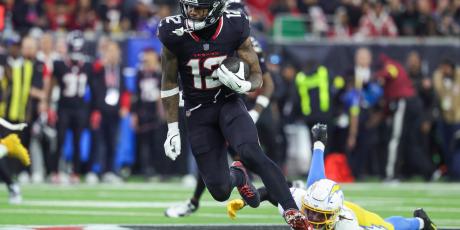The Best Fantasy Football League Settings for 2024

In 2024, fantasy football leagues can come in all kinds of shapes and sizes. For a beginner (or even a longtime player), this could become quite confusing — “Superflex 3RR FAAB” sounds more like an NFL play call than a fantasy league setting. So, in this article, I’ll be walking through all of the different fantasy football league formats to help you decide the optimal settings for your league this season.
League Settings
Before getting into any specific settings, let’s first talk about the overarching league formats. There are four main types of leagues you can be a part of in fantasy nowadays: redraft leagues, best ball leagues, dynasty leagues, and keeper leagues.
- Redraft: Redraft leagues are the standard and most popular type of fantasy football league. You hold a draft before the start of each season and select a brand new set of players to be on your team each year. Your team in one year has no impact on your team in any of the following years. Redraft is personally my favorite format because I enjoy having a new set of players to root for every season.
- Best Ball: A popular, new extension of redraft leagues is best ball. Best ball is basically a redraft league without the in-season management. You simply draft a team in the off-season, and each week, your lineup is automatically set so that you start the best players in your lineup. Best Ball is a great option if you are in a lot of leagues and cannot dedicate the time to manage all of them, or want to try out mock drafts with actual stakes in the off-season without the worry of managing your lineup during the year.
- Dynasty: Dynasty leagues are closer to modeling the actual NFL than a fantasy league — I like to think of them as Madden franchises. When you first create the league, you have a “start-up” draft where all the players are selected, similar to a normal redraft league. However, after the first year, instead of redrafting your team, you keep all of your players and simply draft from the incoming batch of rookies. Dynasty leagues are a great option if you have a committed group of managers in your league who enjoy long-term team building and decision making.
- Keeper: Keeper leagues are somewhat of a middle ground between redraft and dynasty. Keeper leagues allow you to keep players (typically one to three) year to year and forfeit the draft pick you took them at the prior season. For example, let’s say I took Josh Allen in the third round last season. If I were in a keeper league, I could choose to “keep” Josh Allen instead of picking in the third round this season. Keeper leagues are a fun way to further incentivize drafting late-round gems, as you could potentially get an elite player for multiple seasons at a steep bargain.
As for the number of teams in your league, any number between 8 and 16 should be competitive and fun. Ideally, you will have 10 or 12 teams to make sure rosters aren’t too stacked or too barren. But, fantasy football is all about having fun with your friends so don’t let league sizes get in the way of adding people who want to play.
Scoring Settings
There are a lot of different options for how your league is scored. When it comes to yardages and touchdowns, I like to stick to the typical system: 0.04 points per passing yard, 0.1 points per rushing or receiving yard, 4 points per passing touchdown, and 6 points per rushing or receiving touchdown. You could increase passing touchdown scoring to 6 points if you want to see higher scoring totals or even out the advantage of rushing quarterbacks, but those are generally the optimal settings.
Where things get interesting is bonus points that are awarded to pass catchers. Here’s a breakdown of the different options:
- Points per reception (PPR): There are three types of PPR scoring: standard, half-PPR, and full PPR. Standard simply means players do not get any extra points for catching a pass. Half-PPR means players get an extra 0.5 points for catching a pass, and full PPR means they get an extra 1 point. Standard is probably a misnomer nowadays — there are hardly any leagues with no form of PPR these days as receivers and running backs need a way to be more balanced scoring wise. You can’t go wrong with either half or full PPR. I personally like half PPR because I’m a fan of bellcow running backs being rewarded a little more, but both options are certainly valid.
- Tight end (TE) premium: TE premium is a newer development in fantasy that essentially gives tight ends double the points per reception than other positions. It was initially created because the tight end position became a wasteland in fantasy football with a very limited amount of quality starting options. I honestly prefer default tight end scoring because I like the nuance of deciding whether you want to take a dominant tight end like Travis Kelce early on or not. However, TE premium is by no means a bad idea and certainly has its benefits too.
- Points per first down (PPFD): Another PPR alternative that is quickly becoming popular is points per first down. Essentially, instead of a player getting an extra point every time they catch a pass, they get an extra point every time they get a first down. I like PPFD because it models the actual NFL a lot more than PPR does:
Just a couple of guys scoring 1.3 PPR points pic.twitter.com/kWCCsfxvLD
— Ian Hartitz (@Ihartitz) December 4, 2023
Roster Settings
One of the most important things to understand before your draft is the roster makeup of the league, as different roster settings could heavily impact your strategy. The standard league will probably be as follows: 1 QB, 2 RB, 2 WR, 1 TE, 1 Flex (WR/RB/TE), 1 Kicker, 1 D/ST. This is a well-balanced roster format that values skill position players a bit more than quarterbacks. Several members of the fantasy football community have started to remove the Kicker position from their leagues, but I strongly disagree with them. Kickers are a vital part of the NFL and they add a fun bit of strategy to your lineup each week, so why not keep them around?
A lot of the fantasy football content you see will be based on these settings, including the incredibly useful Underdog ADP tool.
With this being said, here are the main modifications to the standard roster settings that you might encounter.
- Superflex/2QB: Superflex or 2QB leagues are probably the most common extension to fantasy leagues, and also the most impactful. The key difference is that in Superflex leagues, you start an extra player each week that can be a QB, RB, WR, or TE. 2QB leagues are the same, but the extra player has to be another QB. The two are essentially the same as you are heavily encouraged to use the extra spot to start a QB in Superflex as QBs score the most points of all positions. Being in a Superflex league will impact your draft strategy a lot. In Superflex leagues, quarterbacks become much more valuable than the other positions because you will start anywhere from 16-32 quarterbacks each week depending on your league size. Superflex drafts will likely resemble what would happen if the actual NFL had a redraft, with all of the elite quarterbacks going at the top. A full breakdown of the differences in strategy between standard and Superflex leagues can be found here.
- Individual Defensive Player (IDP): Individual Defensive Player (IDP) leagues are a format where you draft individual defensive players instead of team defense and special teams. IDP players score fantasy points by getting tackles, sacks, interceptions, etc. IDP leagues are a fun way to include the defensive side of football more in fantasy and give you a deeper dive into the NFL.
Draft Settings
The two main types of drafts in fantasy football are snake drafts and salary cap drafts. In a snake draft, the draft order reverses each round, meaning the team that picks first in the first round will pick last in the second round, and so on. Snake drafts help balance out the advantage of having an earlier first-round pick, and are the most common method for drafting in fantasy football.
Salary cap drafts are a bit more complex but add a lot of strategy to your draft. Each manager has a budget (usually $200) to bid on players. Managers take turns nominating players, and the highest bidder wins the player for their team. Salary cap drafts allow you to target and acquire any player you want, as long as you manage your budget effectively. This format can be a bit more time-consuming but could also add a lot of flavor and excitement to your league.
Here are a couple of smaller notes related to snake draft leagues:
- Third-round reversal (3RR): 3RR is a tweak to traditional snake drafts that balances out the top and bottom picks even more. In a 3RR draft, the draft order reverses after the first two rounds and then follows a typical snake pattern from the third round onward. For example, if you have the last pick in the first round in a 3RR draft, you will pick first in the second and third rounds, and then last again in the fourth round.
- Draft pick trading: Draft pick trading is a lot more popular in dynasty leagues where you can trade future picks during the season, but I want to make the case for pick trading in redraft. Making trades is one of the most fun parts of the fantasy football season, and draft pick trading allows you to keep that aspect all year round. Pick trading makes your team-building strategy even more exciting, as you can decide to sacrifice depth and trade up for more early-round picks or vice versa. If you plan on allowing draft pick trading, make sure to finalize your draft order earlier in the off-season to give managers time to mock draft and determine the rounds they value more than others.
Waiver Wire Settings
The waiver wire is where you win your fantasy league. In-season acquisitions are the key to rounding out your roster and building a dominant team. There are two main types of waiver wire settings in fantasy football: Free Agent Acquisition Budget (FAAB) and Waiver Priority.
- Free Agent Acquisition Budget (FAAB): I don’t have a strong opinion on most of these league settings, but I will die on the hill that all leagues should have a FAAB waiver wire. In FAAB, each manager has a budget (usually $100) to spend on free agents throughout the season. When you want to add a player, you place a blind bid, and the highest bid wins the player. FAAB adds a dynamic component of strategy to your league and is a very fair waiver system. “Continuous FAAB” means that bids can be placed and processed every day or on specified days of the week, while “Non-continuous FAAB” typically processes bids once a week.
- Waiver Priority: Waiver priority is the old-school waiver wire method where each team is assigned a priority, and once they make a waiver claim they are moved to the end of the priority queue. Priority is typically determined by the inverse order of the standings. Waiver priority is a solid option as it gives the worst teams the first opportunity to add new players, but it also has its flaws — early-season waiver acquisitions are often the most impactful (like Puka Nacua last year), and a team who simply has a bad Week 1 might get first priority in a Waiver Priority and add the top player on waivers based on a very small sample size of their team’s performance.
Miscellaneous
Here are a couple other interesting settings that you might consider adding to your league.
- Playoff spot to highest remaining scorer: Some leagues offer a playoff spot to the highest remaining scorer who is not already qualified based on record. This setting rewards teams that score a lot of points but might have been unlucky in their weekly matchups. It ensures that strong teams have a fair shot at the playoffs, even if their win-loss record doesn’t reflect the quality of their lineup.
- Extra matchup every week vs. median: To reduce the impact of unlucky matchups, some leagues use an extra matchup against the median each week. In this format, in addition to your head-to-head matchup, you also compete against the league’s median score for the week. If you score above the median, you get an additional win, and if you score below the median, you get an additional loss. This helps balance the standings and rewards consistently high-scoring teams.
The Bottom Line
Hopefully, you now have a good understanding of the different fantasy football league settings. I’ll close this article with my ideal league format for 2024, which goes as follows: 12-team redraft PPFD with standard roster settings (1 QB, 2 RB, 2 WR, 1 TE, 1 Flex (WR/RB/TE), 1 Kicker, 1 D/ST), draft pick trading, FAAB waivers, and the top six teams by record make the playoffs.
Keep in mind that these are just my personal preferences (I’m admittedly a bit of a traditionalist). As long as everyone in your league is having fun playing fantasy football, any and all of the league settings are a good option. Just make sure to use FAAB.



















